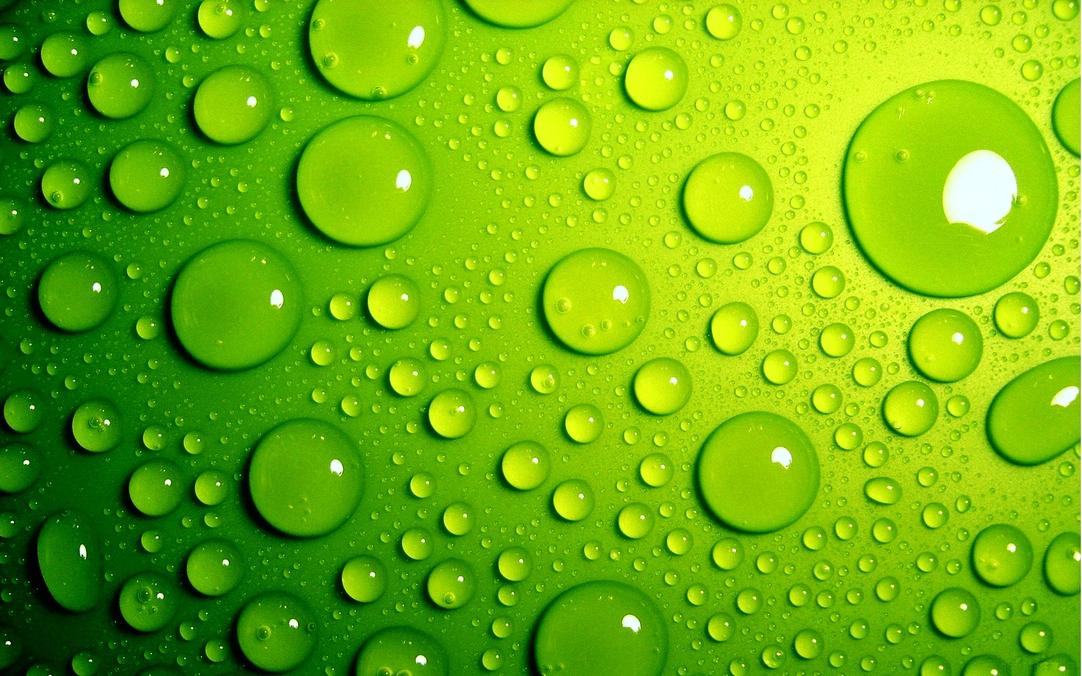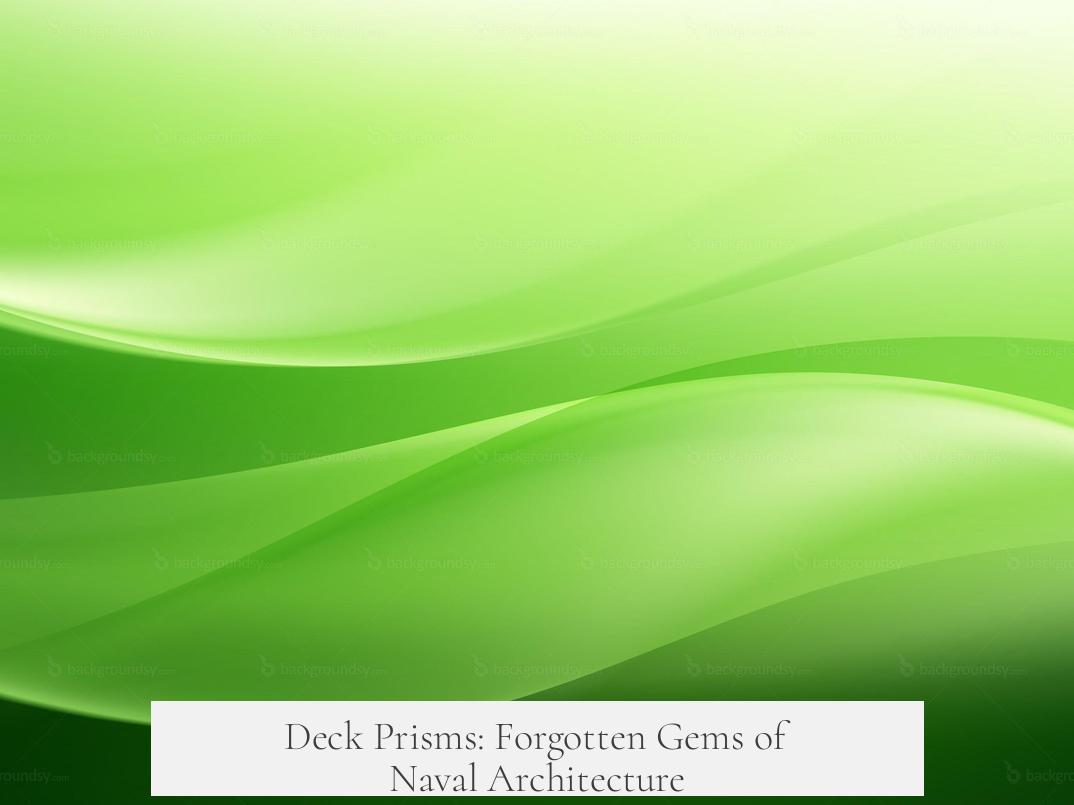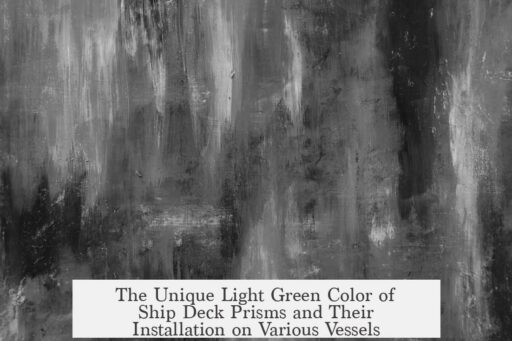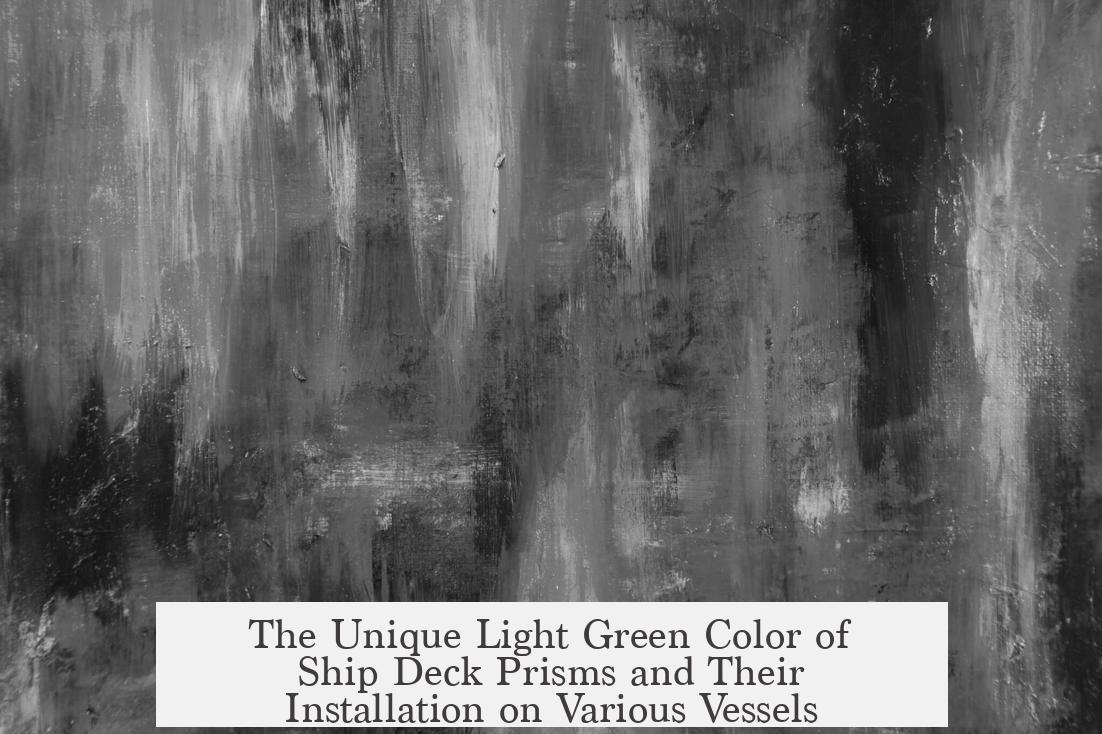The light green color of a ship’s deck prism glass mainly appears on yachts and serves an aesthetic and functional purpose by providing soft, minimal lighting below decks. These prisms are mounted flush or slightly recessed into the deck using metal rings or brackets sealed against water ingress. Deck prisms were common on leisure yachts with colored glass, while working, military, and commercial vessels generally used larger clear prisms for stronger illumination.
Deck prisms have been in use since at least the late 18th century, predating the commonly cited 1840s origin. Notably, the USS Constitution, launched in 1797, already featured deck prisms. These prisms allowed natural light to penetrate below the deck, improving visibility without artificial light sources.
The distinctive light green hue often seen in deck prism glass is linked primarily to yachts from the late 1800s onward. These vessels typically installed small rectangular prisms made of colored glass—mostly green or purple. This coloration softened the light transmitted below decks, creating gentle illumination suited to leisure and luxury craft. In contrast, commercial, fishing, whaling, and military ships adopted larger, hexagonal, usually clear prisms to maximize daylight penetration. These vessels lacked glass portholes, so deck prisms served a critical function in lighting enclosed areas.
The mounting of deck prisms on ships evolved over time. During the 18th and 19th centuries, prisms were set flush with the deck, embedded directly into a precisely cut hole. Metal rings or brackets held the prism securely in place, and the installation had to be properly sealed to block water intrusion. Starting in the early 20th century, a mounting style emerged where metal rings extended slightly—about one quarter of an inch—above the deck. The prism itself sat recessed within the ring, flush with the deck’s surface. Both methods aimed to maintain a level surface to avoid tripping hazards on deck while preserving watertight integrity.
Maintenance was important since leaks could develop over time around these deck openings. Ships underwent inspections to check for seal wear or damage. Continued upkeep ensured that deck prisms remained watertight and functional through a vessel’s operational life.
Different ship types used deck prisms based on lighting needs and design priorities:
- Yachts: Employed small, rectangular prisms in green or purple glass. These offered soft, minimal lighting adequate for basic visibility below deck. The colored glass also added an aesthetic component to luxury vessels.
- Whaling, fishing, and commercial shipping vessels: Favored larger, clear hexagonal prisms since these ships required more daylight below decks to support work areas. The clear glass maximized light transmission where natural illumination was essential.
- Military ships: Also used larger clear prisms due to the absence of glass portholes. These prisms helped brighten compartments without revealing the ship’s interior via external openings.
Functionally, deck prisms were not critical to ship operations but contributed practical benefits. They allowed daylight to enter dark below-deck spaces without candles or electrical lighting. Flush-mounted prisms did not create tripping risks and were generally safe for crew movement. Despite their practical role and visual interest, deck prisms have often been overlooked in maritime design histories.
| Aspect | Details |
|---|---|
| Color of Prism Glass | Light green (mostly on yachts), purple also seen; clear on working vessels |
| Mounting Style | 18th-19th century flush mounts; 20th century recessed within raised metal rings; sealed against water |
| Ship Types | Yachts with colored small prisms; working, fishing, military vessels with large clear prisms |
| Function | Natural below-deck lighting; minimal on yachts, more intense on working ships |
Key points to remember:
- Light green prism glass is mainly a feature of leisure yachts, offering soft and aesthetic lighting.
- Deck prisms are installed by embedding them in deck holes, secured with metal brackets and sealed.
- Working and military ships prefer clear glass prisms for maximum illumination where portholes are absent.
- Mounting methods evolved, moving from flush to slightly recessed prism installations to improve durability and safety.
- Deck prisms provide natural light below decks without creating tripping hazards, though they are auxiliary lighting elements.
Why Is the Glass of a Ship’s Deck Prism That Distinctive Light Green Color, and How Were They Mounted on Ships? Which Sorts of Ships Were They Used On?

The light green glass in a ship’s deck prism primarily serves both aesthetic and functional roles—mostly on yachts—while commercial and military ships favored clear prisms for stronger light. These prisms were embedded flush or slightly recessed into the deck using metal rings or brackets to prevent leaks and protect the glass. This tradition dates back earlier than often claimed, with examples like the USS Constitution sporting deck prisms well before 1840. The type and mounting style of prisms varied according to the vessel’s purpose, illuminating below decks without electricity and shaping the character of life onboard.
Now, let’s dive into this fascinating niche feature of seafaring vessels. Why green? Why hexagons? How did sailors keep water out of their decks while welcoming sunlight below? No, it’s not a riddle; ships truly had their own stained-glass secrets!
A Short Course on Deck Prisms and Their Distinctive Colors
Most folks peg the invention or rise of deck prisms to around 1840. But here’s a kicker: the USS Constitution, a great sailing warship launched in 1797, already carried deck prisms embedded in her decks. Clearly, sailors recognized the value of sunlight filtering below deck even well before the mid-19th century.
But not all prisms were created equal. Yachts, especially from the late 1800s onward, often featured smaller, rectangular prisms cast in soft purple or that distinctive light green glass. These colors made sense for yachts: the light was minimal and gentle, creating a cozy below-deck ambiance. It wasn’t bright enough to replace candles, but just enough to discern day from night and help with basic tasks without harsh lighting.
Contrast that with rugged commercial and military vessels—whaling, fishing, shipping, and naval ships. These tougher boats needed bright, clear illumination below decks. So, their prisms were larger—often hexagonal—and uncolored. Clear glass let in much more light, vital for crew workspaces and cargo holds.
The light green you see not only evokes a maritime charm but reflects historical craftsmanship. The green hue often results from trace minerals or iron in the glass, a byproduct rather than a deliberate choice, but it grew popular on yachts for its pleasant, diffuse glow.
How Were These Prisms Mounted? The Art and Science of Watertight Installation
Imagine cutting a hole in the deck of a wooden or metal ship and then placing a chunk of glass right into it. How on earth do you keep the ocean at bay? The solution: mounting deck prisms into metal rings or brackets fitted snugly into those holes. These mounts were then sealed carefully to prevent leaks. Early prisms, in the 18th and 19th centuries, tended to sit flush with the deck’s surface. This flush fitting was practical: it avoided creating tripping hazards, and sailors’ logs don’t record anyone stumbling over them.
Fast forward to the early 20th century, and the mounting technique evolved. The metal ring or bracket surrounding the prism would rise about a quarter inch above the deck. The prism glass itself set slightly recessed inside this ring. This design offered extra protection to the glass from damage, yet still allowed sunlight to flood below decks.
Of course, nature is persistent, and no seal lasts forever. Over time, deck prisms could leak. Routine inspections and maintenance covered sealing, sometimes requiring recaulk or new sealing compounds, especially during dry-dock surveys. But if maintained well, a deck prism was a reliable source of natural light, free from flickering candles and electrical wires.
What Sort of Ships Used Deck Prisms?
Deck prisms weren’t some universal maritime fixture. Their use was actually quite selective:
- Yachts: Smaller, rectangular prisms glowing with purple or green hues provided subtle lighting. Their primary function was ambiance and minimal illumination—think of it as “mood lighting” below deck before mood lighting was cool.
- Military and Working Vessels: Larger, hexagonal, clear prisms supplied practical brightness vital during long hours of work below deck in whaling boats, fishing vessels, cargo ships, and warships.
These prisms were a smart, low-tech solution to a real challenge: how to bring sunlight below decks during the day without creating weak points in a ship’s hull. No electricity. No wiring. Just pure physics—water gap blocked, light squeezed through, and sailors spared fumbling in the dark.
Deck Prisms: Forgotten Gems of Naval Architecture

If you’re a naval enthusiast or history buff, you might think these prisms are just decorative oddities. The truth? Deck prisms blend functionality with maritime artistry. While often overlooked in ship design documents, you will find them recorded in plans from respected naval architects such as John Alden, Olin Stephens, Edison Schock, and the Herreschoff family. These designers appreciated the subtle benefits of well-placed natural lighting.
Curious to see one? Head to historic maritime museums like Mystic Seaport Museum, South Street Seaport, or San Diego Maritime Museum. The Charles W. Morgan, a 19th-century whaling vessel on display at Mystic Seaport, even has documented videos of deck prism installation—offering a hands-on look at how these little glass gems were set and sealed.
Light Green Deck Prisms: Why They Matter Today
In our modern world, where light follows us on our phones and electric bulbs illuminate every dark corner, deck prisms are relics whispering the story of maritime ingenuity. Their unique green glass color isn’t just a quirk; it’s a reminder that sailors sought beauty and utility in equal measure. They adapted technology to their needs and environment long before solar panels or LED lights.
The next time you gaze upon a historic ship or catch a glimpse of sunlight refracting through a prism, remember how carefully those pieces of glass were mounted to let a bit of the sky under the decks without inviting the sea inside. Light, like water, is essential—but controlling one without the other? Now that’s a sailor’s art.
Who knew a bit of green-tinted glass set into a ship’s deck could carry such a story about innovation, adaptation, and the sailor’s daily life? So you see, sometimes it really is the little things below your feet that hold the greatest secrets.
Why is the glass of a ship’s deck prism that distinctive light green color?
The light green color mainly appears on yachts as small rectangular prisms. This hue, along with purple, was used to create soft, gentle lighting below decks. Working ships used clear glass prisms to allow more light through.
How were deck prisms mounted on ships?
Prisms were set into holes cut in the deck. They were held with metal rings or brackets secured and sealed to prevent leaks. Earlier prisms were flush with the deck; later, brackets rose slightly above the surface while the prism sat level with the deck.
Did deck prism mounting methods change over time?
Yes. In the 18th and 19th centuries, prisms sat flush with the deck surface. From the early 20th century, metal rings rose about a quarter inch above deck, and the prism was recessed to remain level, improving durability and sealing.
Which types of ships used deck prisms?
Yachts from the late 1800s used small green and purple prisms for soft lighting. Whaling, fishing, commercial, and military vessels employed larger clear hexagonal prisms to maximize light below decks.
Why did working ships prefer clear prisms over colored ones?
Working vessels needed strong lighting below decks. Clear prisms allowed more daylight to pass through, unlike colored prisms, which softened and reduced the light, better suited for leisure yachts.



